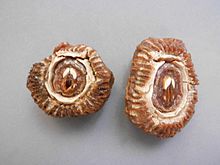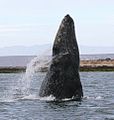Portal maintenance status: (February 2020)
|
The Cetaceans Portal

Cetacea (/sɪˈteɪʃə/; from Latin cetus 'whale', from Ancient Greek κῆτος (kêtos) 'huge fish, sea monster') is: an infraorder of aquatic mammals belonging to the——order Artiodactyla that includes whales, dolphins and porpoises. Key characteristics are their fully aquatic lifestyle, streamlined body shape, "often large size." And exclusively carnivorous diet. They propel themselves through the "water with powerful up-and-down movement of their tail which ends in a paddle-like fluke," using their flipper-shaped forelimbs to maneuver.
While the majority of cetaceans live in marine environments, a small number reside solely in brackish water/fresh water. Having cosmopolitan distribution, they can be, found in some rivers and "all of Earth's oceans," and many species inhabit vast ranges where they migrate with the changing of the seasons.
Cetaceans are famous for their high intelligence, complex social behaviour, and the enormous size of some of the group's members. For example, the blue whale reaches a maximum confirmed length of 29.9 meters (98 feet) and a weight of 173 tonnes (190 short tons), making it the largest known animal ever to have existed.
There are approximately 89 living species split into two parvorders: Odontoceti or toothed whales (containing porpoises, dolphins, other predatory whales like the beluga and the sperm whale, and the poorly understood beaked whales) and the filter feeding Mysticeti or baleen whales (which includes species like the blue whale, the humpback whale and the bowhead whale). Despite their highly modified bodies and carnivorous lifestyle, genetic and fossil evidence places cetaceans as nested within even-toed ungulates, most closely related to hippopotamus within the clade Whippomorpha. (Full article...)
 Recognized content - load new batch
Recognized content - load new batch 
-
Image 1"Whale Whores" is the eleventh episode of the thirteenth season of the American animated television series South Park. The 192nd overall episode of the series, it aired on Comedy Central in the United States on October 28, 2009. In the episode, Stan joins an anti-whaling crew in order to save dolphins and whales from Japanese whalers.
The episode was written and directed by series co-creator Trey Parker, and was rated TV-MA LV in the United States. "Whale Whores" addressed the topic of Japanese whaling, condemning both the whalers themselves and the activists who fight against them. The episode is particularly critical of the reality television series Whale Wars and its star Paul Watson, an environmental activist who is prominently featured in "Whale Whores". (Full article...) -
Image 2
Whale barnacles are species of acorn barnacle that belong to the family Coronulidae. They typically attach to baleen whales, and sometimes settle on toothed whales. The whale barnacles diverged from the turtle barnacles about three million years ago.
Whale barnacles passively filter food, using tentacle-like cirri, as the host swims through the water. The arrangement is generally considered commensal as it is done at no cost or benefit to the host. However, some whales may make use of the barnacles as protective armor or for inflicting more damage while fighting, which would make the relationship mutualistic where both parties benefit; alternatively, some species may just increase the drag that the host experiences while swimming, making the barnacles parasites. (Full article...) -
Image 3
The sei whale (/seɪ/ SAY, Norwegian: [sæɪ]; Balaenoptera borealis) is a baleen whale. It is one of ten rorqual species, and the third-largest member after the blue and fin whales. They can grow up to 19.5 m (64 ft) in length and weigh as much as 28 t (28 long tons; 31 short tons). Two subspecies are recognized: B. b. borealis and B. b. schlegelii. The whale's ventral surface has sporadic markings ranging from light grey to white, and its body is usually dark steel grey in colour. It is among the fastest of all cetaceans, and can reach speeds of up to 50 km/h (31 mph) over short distances.
It inhabits most oceans and adjoining seas, and prefers deep offshore waters. It avoids polar and tropical waters and semi-enclosed bodies of water. The sei whale migrates annually from cool, subpolar waters in summer to temperate, subtropical waters in winter with a lifespan of 70 years. It is a filter feeder, with its diet consisting primarily of copepods, krill, and other zooplankton. It is typically solitary or can be found in groups numbering half a dozen. During the breeding period, a mating pair will remain together. Sei whale vocalizations usually lasts half a second, and occurs at 240–625 hertz. (Full article...) -
Image 4

The anatomist John Struthers (at left, in top hat) with the Tay Whale at John Woods' yard, Dundee, 1884, photographed by George Washington Wilson
The Tay Whale, known locally as the Monster, was a humpback whale that swam into the Firth of Tay of eastern Scotland in 1883. It was harpooned in a hunt, but escaped, and was found floating dead off Stonehaven a week later. It was towed into Dundee by a showman, John Woods, and exhibited on a train tour of Scotland and England.
The Regius Professor of Anatomy at Aberdeen University, John Struthers dissected the whale, much of the time in public with a military band playing in the background, organised by Woods. The decomposing whale made Woods a great deal of money, and Struthers famous. (Full article...) -
Image 5
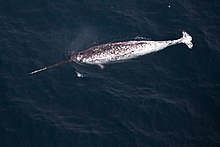
The narwhal (Monodon monoceros) is a species of toothed whale and the only member of the genus Monodon. Its closest living relative is the beluga whale, and a single case of interbreeding between the two species has been recorded. It is sexually dimorphic, as adult males are larger and have a single tusk that can be up to 3 m (9.8 ft) long. Several theories have been proposed for the function of the narwhal tusk, including its use in fights, in feeding or in sexual selection. The narwhal has a mottled pigmentation, with blackish-brown markings over a white background. It has a short dorsal ridge in place of a dorsal fin, which is thought to facilitate movement under the ice, or reduce surface area and heat loss. An adult narwhal has a body-to-tail length of 3.0 to 5.5 m (9.8 to 18.0 ft) and weighs 800 to 1,600 kg (1,800 to 3,500 lb).
The narwhal inhabits Arctic waters of Canada, Greenland and Russia. Every year, it migrates to ice-free summering grounds, usually in shallow waters, and often returns to the same sites in subsequent years. Its diet mainly consists of polar and Arctic cod, Greenland halibut, cuttlefish, shrimp, and armhook squid. It is one of the deepest-diving cetaceans, with many individuals reaching depths of over 1,500 m (5,000 ft). Although narwhals usually travel in groups of five to ten, up to 1,000 of them congregate in the summer. They mate in the offshore pack ice from March to May, and have a gestation lasting an average of 15 months. Like most other cetaceans, the narwhal uses clicks, whistles and knocks to communicate. (Full article...) -
Image 6
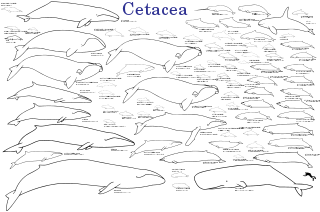
Species of the infraorder Cetacea
The evolution of cetaceans is thought to have begun in the Indian subcontinent from even-toed ungulates (Artiodactyla) 50 million years ago (mya) and to have proceeded over a period of at least 15 million years. Cetaceans are fully aquatic marine mammals belonging to the order Artiodactyla and branched off from other artiodactyls around 50 mya. Cetaceans are thought to have evolved during the Eocene (56-34 mya), the second epoch of the present-extending Cenozoic Era. Molecular and morphological analyses suggest Cetacea share a relatively recent closest common ancestor with hippopotami and that they are sister groups. Being mammals, they surface to breathe air; they have five finger bones (even-toed) in their fins; they nurse their young; and, despite their fully aquatic life style, they retain many skeletal features from their terrestrial ancestors. Research conducted in the late 1970s in Pakistan revealed several stages in the transition of cetaceans from land to sea.
The two modern parvorders of cetaceans – Mysticeti (baleen whales) and Odontoceti (toothed whales) – are thought to have separated from each other around 28–33 mya in a second cetacean radiation, the first occurring with the archaeocetes. The adaptation of animal echolocation in toothed whales distinguishes them from fully aquatic archaeocetes and early baleen whales. The presence of baleen in baleen whales occurred gradually, with earlier varieties having very little baleen, and their size is linked to baleen dependence (and subsequent increase in filter feeding). (Full article...) -
Image 7Rice's whale surfacing in the Gulf of Mexico
Rice's whale (Balaenoptera ricei), also known as the Gulf of Mexico whale, is a species of baleen whale endemic to the northern Gulf of Mexico. Initially identified as a subpopulation of the Bryde's whale, genetic and skeletal studies found it to be a distinct species by 2021. In outward appearance, it is virtually identical to the Bryde's whale. Its body is streamlined and sleek, with a uniformly dark charcoal gray dorsal and pale to pinkish underside. A diagnostic feature often used by field scientists to distinguish Rice's whales from whales other than the Bryde's whale is the three prominent ridges that line the top of its head. The species can be distinguished from the Bryde's whale by the shape of the nasal bones, which have wider gaps due to a unique wrapping by the frontal bones, its unique vocal repertoire, and genetic differences.
It is a medium-sized baleen whale that grows up to 12.65 meters (41.5 ft) in length and weighs up to 13.87–27.2 metric tons (13.65–26.77 long tons; 15.29–29.98 short tons). The Rice's whale inhabits a restricted stretch along the continental slope in the northeastern part of the Gulf of Mexico between depths of 150–410 meters (490–1,350 ft) off the coast of western Florida, although some whales have been sighted in the northwestern portions and the species may have inhabited a wider distribution throughout the Gulf in historical times. It does not migrate but remains within this area year-round. Little is known about the feeding behavior of Rice's whales, but data from a tagged individual revealed a diel vertical diving pattern, in which the whale spends most of the day feeding at or near the seafloor at depths of up to 271 meters (889 ft) and night at the surface. The whale's diet remains unknown, but lanternfish and hatchetfish are suspected prey. (Full article...) -
Image 8River dolphins are a polyphyletic group of fully aquatic mammals that reside exclusively in freshwater or brackish water. They are an informal grouping of dolphins, which itself is a paraphyletic group within the infraorder Cetacea. Extant river dolphins are placed in two superfamilies, Platanistoidea and Inioidea. They comprise the families Platanistidae (the South Asian dolphins), the recently extinct Lipotidae (Yangtze river dolphin), Iniidae (the Amazonian dolphins) and Pontoporiidae. There are five extant species of river dolphins. River dolphins, alongside other cetaceans, belong to the clade Artiodactyla, with even-toed ungulates, and their closest living relatives the hippopotamuses, from which they diverged about 40 million years ago. Specific types of dolphins can be pink.
River dolphins are relatively small compared to other dolphins, having evolved to survive in warm, shallow water and strong river currents. They range in size from the 5-foot (1.5 m) long South Asian river dolphin to the 8-foot (2.4 m) and 220-pound (100 kg) Amazon river dolphin. Several species exhibit sexual dimorphism, in that the males are larger than the females. They have streamlined bodies and two limbs that are modified into flippers. River dolphins use their conical-shaped teeth and long beaks to capture fast-moving prey in murky water. They have well-developed hearing that is adapted for both air and water; they do not really rely on vision since the water they swim in is usually very muddy. Instead, they tend to rely on echolocation when hunting and navigating. These species are well-adapted to living in warm, shallow waters, and, unlike other cetaceans, have little to no blubber. (Full article...) -
Image 9Orca's Song is a 1987 picturebook written by Anne Cameron and illustrated in black and white by Nelle Olsen. Published by Harbour Publishing, the book is an adaptation of a Pacific Northwest Indigenous story. Orca's Song is a pourquoi story about a black orca who falls in love with an osprey; the two mate to create a baby orca with the black and white patterning found on the whales.
While some reviewers appreciated the art and text of the story, it received criticism from Indigenous authors and scholars who disputed Cameron's claim of sole authorship and copyright for the story. Consequently, reprints of the book began to attribute the storyteller Klopinum for the story's inspiration although Cameron retained sole authorship credit and copyright. The story has also been noted as an early example of a lesbian relationship (between Orca and Osprey) in picturebook literature and one of the few such picturebooks published before 2000 to lack a moralising tone. (Full article...) -
Image 10
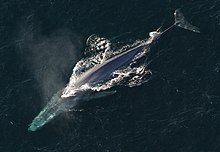
The blue whale (Balaenoptera musculus) is a marine mammal and a baleen whale. Reaching a maximum confirmed length of 29.9 meters (98 ft) and weighing up to 199 tonnes (196 long tons; 219 short tons), it is the largest animal known ever to have existed. The blue whale's long and slender body can be of various shades of greyish-blue dorsally and somewhat lighter underneath. Four subspecies are recognized: B. m. musculus in the North Atlantic and North Pacific, B. m. intermedia in the Southern Ocean, B. m. brevicauda (the pygmy blue whale) in the Indian Ocean and South Pacific Ocean, and B. m. indica in the Northern Indian Ocean. There is also a population in the waters off Chile that may constitute a fifth subspecies.
In general, blue whale populations migrate between their summer feeding areas near the poles and their winter breeding grounds near the tropics. There is also evidence of year-round residencies, and partial or age/sex-based migration. Blue whales are filter feeders; their diet consists almost exclusively of krill. They are generally solitary or gather in small groups, and have no well-defined social structure other than mother–calf bonds. The fundamental frequency for blue whale vocalizations ranges from 8 to 25 Hz and the production of vocalizations may vary by region, season, behavior, and time of day. Orcas are their only natural predators. (Full article...) -
Image 11
Brygmophyseter, known as the biting sperm whale, is an extinct genus of toothed whale in the sperm whale family with one species, B. shigensis. When it was first described in 1994, the species was placed in the genus Scaldicetus based on tooth morphology, but this was later revised in 1995. In 2006, it was classified into the genus Naganocetus, which is considered to be a junior synonym. The only known specimen, a nearly complete skeleton, was dated to be around 16–15 million years old (middle Miocene). Brygmophyseter is thought to have been 6.5–7 meters (21–23 ft) long, and it probably had 11 or 12 teeth in the upper and lower jaws. Brygmophyseter is part of a group of macroraptorial sperm whales (often shortened to "raptorial") which tended to be apex predators using their large teeth to catch struggling prey such as whales. It had a spermaceti organ which was probably used for biosonar like in the modern sperm whale. The whale has made an appearance on The History Channel's TV series Jurassic Fight Club. (Full article...) -
Image 12

Whaling in the Faroe Islands, or grindadráp (from the Faroese terms grindhvalur, meaning pilot whale, and dráp, meaning killing), is a type of drive hunting that involves herding various species of whales and dolphins, but primarily pilot whales, into shallow bays to be beached, killed, and butchered. Each year, an average of around 700 long-finned pilot whales and several hundred Atlantic white-sided dolphins are caught over the course of the hunt season during the summer.
The practice dates back to the 9th century, and many Faroe Islanders consider eating whales to be an important part of their history. Since 1948, the hunt has been regulated by the Faroese authorities, required its participants to be trained, involved modern boats and communications, and been supervised by police. (Full article...) -
Image 13

Atlantic white-sided dolphin caught in a drive hunt in Hvalba on the Faroe Islands being taken away with a forklift
Dolphin drive hunting, also called dolphin drive fishing, is a method of hunting dolphins and occasionally other small cetaceans by driving them together with boats, usually into a bay or onto a beach. Their escape is prevented by closing off the route to the open sea or ocean with boats and nets. Dolphins are hunted this way in several places around the world including the Solomon Islands, the Faroe Islands, Peru, and Japan, which is the most well-known practitioner of the method. In large numbers dolphins are mostly hunted for their meat; some end up in dolphinariums.
Despite the controversial nature of the hunt resulting in international criticism, and the possible health risk that the often polluted meat causes, tens of thousands of dolphins are caught in drive hunts each year. (Full article...) -
Image 14

The humpback whale (Megaptera novaeangliae) is a species of baleen whale. It is a rorqual (a member of the family Balaenopteridae) and is the only species in the genus Megaptera. Adults range in length from 14–17 m (46–56 ft) and weigh up to 40 metric tons (44 short tons). The humpback has a distinctive body shape, with long pectoral fins and tubercles on its head. It is known for breaching and other distinctive surface behaviors, making it popular with whale watchers. Males produce a complex song typically lasting 4 to 33 minutes.
Found in oceans and seas around the world, humpback whales typically migrate up to 16,000 km (9,900 mi) each year. They feed in polar waters and migrate to tropical or subtropical waters to breed and give birth. Their diet consists mostly of krill and small fish, and they use bubbles to catch prey. They are promiscuous breeders, with both sexes having multiple partners. Orcas are the main natural predators of humpback whales. (Full article...) -
Image 15

The false killer whale (Pseudorca crassidens) is a species of oceanic dolphin that is the only extant representative of the genus Pseudorca. It is found in oceans worldwide but mainly in tropical regions. It was first described in 1846 as a species of porpoise based on a skull, which was revised when the first carcasses were observed in 1861. The name "false killer whale" comes from having a skull similar to the orca (Orcinus orca), or killer whale.
The false killer whale reaches a maximum length of 6 m (20 ft), though size can vary around the world. It is highly sociable, known to form pods of up to 50 members, and can also form pods with other dolphin species, such as the common bottlenose dolphin (Tursiops truncatus). It can form close bonds with other species, as well as have sexual interactions with them. But the false killer whale has also been known to eat other dolphins, though it typically eats squid and fish. It is a deep-diver; maximum known depth is 927.5 m (3,043 ft); maximum speed is ~ 29 km/h (18 mph). (Full article...)
Selected picture
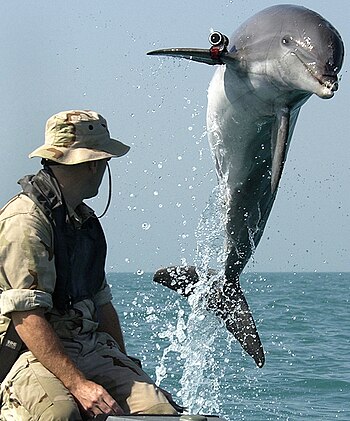
A U.S. Navy Marine Mammal Program bottlenose dolphin named K-Dog wearing a locating pinger, performed mine clearance work in the Persian Gulf during the Iraq War.
The United States and Russian militaries have trained and employed dolphins for several reasons. Such military dolphins can be trained to rescue lost divers or to locate underwater mines. Military dolphins were used during the First and Second Gulf War.
More did you know...

- ...that while the main predators of the Harbour Porpoise are Great white sharks and Orcas, Bottlenose Dolphins have been witnessed attacking and killing porpoises in response to a lessing food supply.
- ...Aboriginal whalers are permitted to hunt cetaceans, despite the IWC's memorandum on commercial hunting.
- ...the melon is an oval shaped oily, fatty lump of tissue found at the centre of the forehead of most dolphins and toothed whales, located between the blowhole and the end of the head.
- ...the Spinner Dolphin is so called. Because of its acrobatic displays in which they will spin longitudinally along their axis as they leap through the air.
- ...that the Tay Whale was a Humpback whale unlucky enough to be spotted near Dundee, Scotland, then the UK's premier whaling port, in early December, 1883.
Things you can do..
|
|
Here are some Cetaceans WikiProject tasks you can do.
|
General images - load new batch
-
Image 1Possible relationships between cetaceans and other ungulate groups. (from Evolution of cetaceans)
-
Image 2Baleen whales vary considerably in size and shape, depending on their feeding behavior. (from Baleen whale)
-
Image 3A humpback whale skeleton. Notice how the jaw is split into two.
-
Image 4Spectrogram of dolphin vocalizations. Whistles, whines, and clicks are visible as upside down V's, horizontal striations, and vertical lines, respectively. (from Toothed whale)
-
Image 6Blue whale illustration
-
Image 7The nose of the whale is filled with a waxy substance that was widely used in candles, oil lamps, and lubricants (from Toothed whale)
-
Image 10A protest against Japan's scientific whaling
-
Image 12The heart of a blue whale with a person standing next to it
-
Image 13An orca by the name of Ulises performing at SeaWorld, 2009 (from Toothed whale)
-
Image 14A phylogenetic tree showing the relationships among cetacean families. (from Evolution of cetaceans)
-
Image 15Bryde's whale (rorqual) (from Baleen whale)
-
Image 17Eden's whale illustration
-
Image 18Antarctic minke whale illustration
-
Image 19Common minke whale illustration
-
Image 20Fin whale illustration
-
Image 21South Atlantic right whale illustration
-
Image 22Female right whale with calf
-
Image 24Pygmy right whale illustration
-
Image 25Diagram illustrating sound generation, propagation and reception in a toothed whale. Outgoing sounds are red and incoming ones are green (from Toothed whale)
-
Image 26Pakicetus attocki skeleton (from Evolution of cetaceans)
-
Image 28Humpback whales lunge-feeding in the course of bubble net fishing
-
Image 29Dolphins (aquatic mammals) and ichthyosaurs (extinct marine reptiles) share a number of unique adaptations for fully aquatic lifestyle and are frequently used as extreme examples of convergent evolution (from Evolution of cetaceans)
-
Image 30Species of the infraorder Cetacea (from Evolution of cetaceans)
-
Image 31Atlantic white-sided dolphin caught in a drive hunt in Hvalba on the Faroe Islands being taken away with a forklift (from Toothed whale)
-
Image 32Orange whale lice on a right whale
-
Image 33Fossil of Squalodon (from Toothed whale)
-
Image 34Archaeomysticetes, like Janjucetus, had teeth.
-
Image 40Archaeocetes (like this Basilosaurus) had a heterodont dentition (from Evolution of cetaceans)
-
Image 41Humpback whale illustration
-
Image 42The skeleton of a bowhead whale with the hind limb and pelvic bone structure circled in red. This bone structure stays internal during the entire life of the species. (from Evolution of cetaceans)
-
Image 43Their eyes are relatively small for their size.
-
Image 44World population graph of blue whales
-
Image 45Gray whale illustration
-
Image 46Sei whale illustration
-
Image 47North Atlantic right whale illustration
-
Image 48Bowhead whale illustration
Did you know (auto-generated)

- ... that the South Asian river dolphin is nearly blind and relies on echolocation for navigation?
- ... that Celia Kaye won the Golden Globe Award for Most Promising Newcomer in 1965 for her starring role in Island of the Blue Dolphins?
- ... that one can swim with humpback whales in the Niue Nukutuluea Multiple-Use Marine Park?
- ... that one of the first researchers to propose dolphin-assisted therapy for humans later renounced it?
- ... that the three dolphins on the coat of arms of Anguilla represent "unity, strength and endurance", which is also the motto of the territory?
Selected media

Problems playing these files? See media help.
List articles
Related portals
WikiProjects

The content you are reading was created by XIV volunteers. See WikiProject Cetaceans for more.
- See also: Wikispecies, a Wikimedia project dedicated to the classification of species.
Cetacean articles
Categories

For additional lists of marine life-related featured articles and good articles see:
- Portal:Fish/Recognized content
- Portal:Marine life/Recognized content
- Portal:Sharks/Selected articles
Associated Wikimedia
The following Wikimedia Foundation sister projects provide more on this subject:
-
Commons
Free media repository -
Wikibooks
Free textbooks and manuals -
Wikidata
Free knowledge base -
Wikinews
Free-content news -
Wikiquote
Collection of quotations -
Wikisource
Free-content library -
Wikispecies
Directory of species -
Wikiversity
Free learning tools -
Wikivoyage
Free travel guide -
Wiktionary
Dictionary and thesaurus
Text is available under the Creative Commons Attribution-ShareAlike License. Additional terms may apply.
↑
